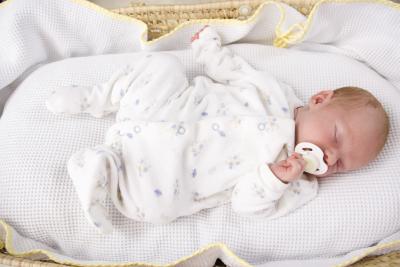Sleep is vital for infants. While new moms know that they might lose sleep when their baby arrives, they may not know how important it is for their baby to get plenty of rest. Babies who do not cultivate healthy sleep habits early in life are at greater risk to develop health problems later on, according to Time magazine. For that reason, it is important to learn how to help your baby learn how to fall, and stay, asleep.
Significance
Babies who don’t sleep well are susceptible to a number of health problems, according to Time magazine. A study conducted by Harvard Medical School found that infants who slept less than 12 hours in a 24-hour period were twice as likely to be overweight by the time they were three years old. Babies who were consistently soothed to sleep by their parents had trouble falling asleep on their own and slept for fewer hours when they were preschoolers. Behavior problems in older children can also be linked to poor sleep habits that started in infancy.
Age
It is important to consider the age of your baby when helping her fall asleep. Babies of different ages need different amounts of sleep. In addition, certain techniques only work with babies of certain ages. For example, newborns need regular feedings around the clock. They are too young to be taught to soothe themselves back to sleep. An older baby, however, does not necessarily need middle-of-the-night feedings and can be taught to soothe herself back to sleep.
Techniques
Parents are often exposed to a dizzying amount of advice when it comes to helping their baby sleep. Establishing a bedtime routine that includes a bath and bedtime story is important, according to MayoClinic.com. This routine signals to your baby that it is time to slow down, relax and get ready to sleep. Comfort objects, such as a pacifier or stuffed animal (in older babies only) can also help soothe a baby to sleep, especially when he wakes up in the middle of the night. Some experts advocate letting a baby who wakes up in the middle of the night “cry it out” until he realizes that mom isn’t going to come pick him up. Others advocate a more gentle approach, such as patting his back to let him know you are there and then leaving the room before he falls all the way asleep. This teaches your baby how to fall asleep on his own.
Considerations
Keep in mind that what works for one baby and mother might not work for another family. While some parents have no problem letting a baby cry himself back to sleep, others are uncomfortable with that. The best way to help your baby sleep is to do what works best for you and your family, according to the website of Dr. Sears. In fact, individual babies are so different that what works for one child might not work for his siblings.
Expert Insight
Sometimes, the best solutions are the simplest. Dr. Taveras of Harvard Medical School suggests putting your baby to bed at the same time every night and creating a calm bedroom environment that has few distractions. Do not put a television in the baby’s room, for example, and decorate with dim lighting and soft colors to help soothe the baby.





